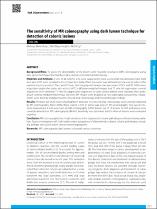The sensitivity of MR colonography using dark lumen technique for detection of colonic lesions
Künye
Beker Acay, M., Bayramoğlu, S., Acay, A. (2014). The sensitivity of MR colonography using dark lumen technique for detection of colonic lesions. Turkish Journal of Gastroenterology, 25(3), 271-278.Özet
Background/Aims: To assess the detectability of the lesions with magnetic resonance (MR) colonography using dark lumen technique that had been detected on conventional colonoscopy. Materials and Methods: A total of 38 patients who were suspected to have a colorectal mass between April 2008 and June 2010 were included in this prospective study. Warm tap water was administered via a rectal tube to the patients in prone position. Then, axial T2 true- fast imaging with steady-state precession (FISP), axial T2 half-Fourier acquisition single-shot turbo spin-echo (HASTE), diffusion-weighted images, and T1 vibe fat suppression coronal sequences were obtained. T1 vibe fat suppression sequences on axial coronal planes were repeated after gadolinium contrast medium intravenous injection. MR images were analyzed by two radiologists concurrently. Assessments were done by comparing with conventional colonoscopy and histopathologic findings. Results: Thirteen out of 20 lesions that had been detected on conventional colonoscopy were correctly obtained by MR colonography. None of the three lesions 5 mm or below was seen on MR colonography. Two out of 4 lesions measuring 6-9 mm were seen on MR colonography (50%). Eleven out of 13 lesions 10 mm and above were correctly detected on MR colonography (84.6%). Sensitivity was estimated as 65% when all lesions were evaluated together. Conclusion: MR colonography has a high sensitivity in the diagnosis of colonic pathologies without ionizing radiation. Future investigation will likely lead to wider acceptance of this method to detect colonic pathologies, including perhaps their use in colon cancer screening programs. © 2014 by The Turkish Society of Gastroenterology.


















